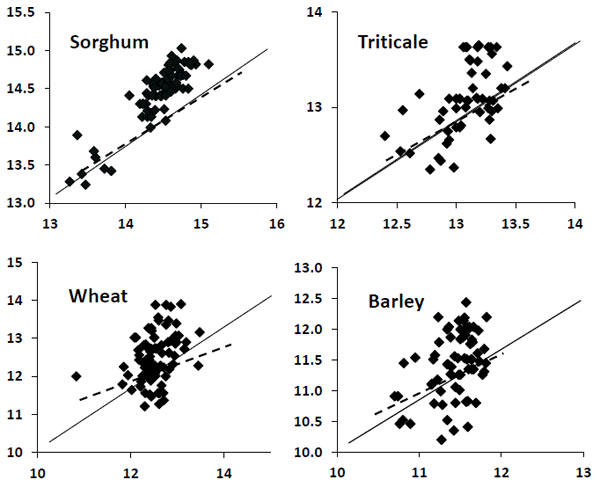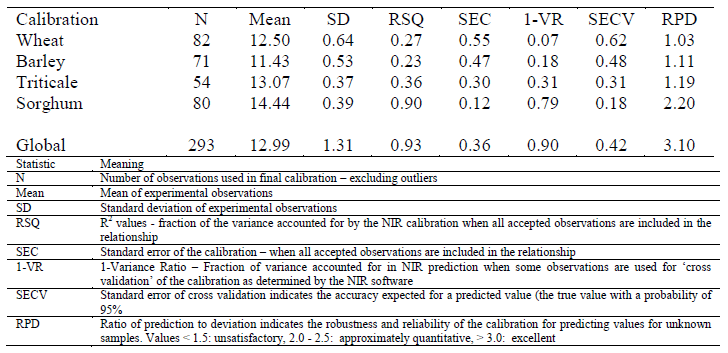I. INTRODUCTION
Cereal grains used by the poultry industry in Australia vary widely in available energy and protein content which is often reflected as variation in bird performance because standardised ingredient values are used for diet formulation. Rapid or real-time techniques for measuring the AME content of grains for birds will assist the purchase of grains at appropriate prices and the accuracy of feed formulation that should result in a marked reduction in variability in nutrients supply across formulated batches of feed.
Calibrations based on NIR spectroscopy for estimating the AME content and AME Intake Index of cereal grains for broiler chickens have been developed in Australia (Black et al., 2009). The calibrations were developed from results obtained in the Premium Grains for Livestock Program. Updated NIR calibrations were reported by Black et al. (2010). AusScan, a business arm of the Pork CRC Ltd, released the latest version of NIR calibrations for broiler chickens in 2012. To date, all AusScan NIR calibrations licensed for industry usage have been of a global nature involving several cereal grain types. Australian users of the calibrations for predicting AME for broilers have expressed interest in the development of single-grain calibrations from existing information in the global database.
This paper compares separate NIR calibrations for predicting AME of wheat, sorghum, barley and triticale with a global calibration involving all cereal grain types.
II. METHOD
The 2012 AusScan calibration for broiler AME is based on 293 grain samples. Single-grain calibrations developed from this database contained 82, 71, 54 and 80 samples for wheat, barley, triticale and sorghum, respectively. The statistical characteristics of the calibrations are summarised in Table 1.
III. RESULTS
Table 1 - Statistical characteristics of the single-grain and global calibrations for broiler AME (MJ/kg as fed basis). Whole grains were scanned in a Foss 6500 spectrophotometer. (Calibrations were developed with WinISI software)
Figure 1 - Measured versus predicted values for AME (MK/kg as fed) for sorghum, triticale, wheat, and barley.
III. DISCUSSION
Measured versus predicted plots of AME (MJ/kg as fed) for wheat, barley, triticale and sorghum (Figure 1) indicate why single-grain calibrations had relatively poor statistical qualities. Sorghum has a reasonable range of values, as do triticale and barley, but the bulk of wheat samples appear in a narrow band (12-13 MJ/kg as fed). Other studies of AME values for 58 samples of wheat from widely separated growing regions in Australia in 2010, 2011 and 2012, showed a large proportion of samples in the range 10.5–12.0 MJ/kg as fed NIR predicted values were overestimates of the measured AME values for these wheats which were regarded as acceptable quality for inclusion in commercial diets. Therefore, it appears that wheats with lower AME values are poorly represented in the AusScan database, and that future work is needed, particularly with the inclusion of new season grains.
In conclusion, the results show that separate cereal grain calibrations were inferior to a global calibration involving all grain types. The usefulness of single-grain calibrations may improve when more grain samples, particularly those with AME values in the upper and lower ends of the ranges, are added to the database.
ACKNOWLEDGMENTS: The RIRDC Chicken Meat Program provided financial support (Projects 2972, 2973, 5121).
REFERENCES
Black JL, Hughes RJ, Nielsen SG, Tredrea AM & Flinn PC (2009) Proceedings of the Australian Poultry Science Symposium 20: 31-34.
Black JL, Hughes RJ, Geier, MS, Nielsen SG, Tredrea AM & Flinn PC (2010) Proceedings of the Australian Poultry Science Symposium 21: 51-54.









.jpg&w=3840&q=75)